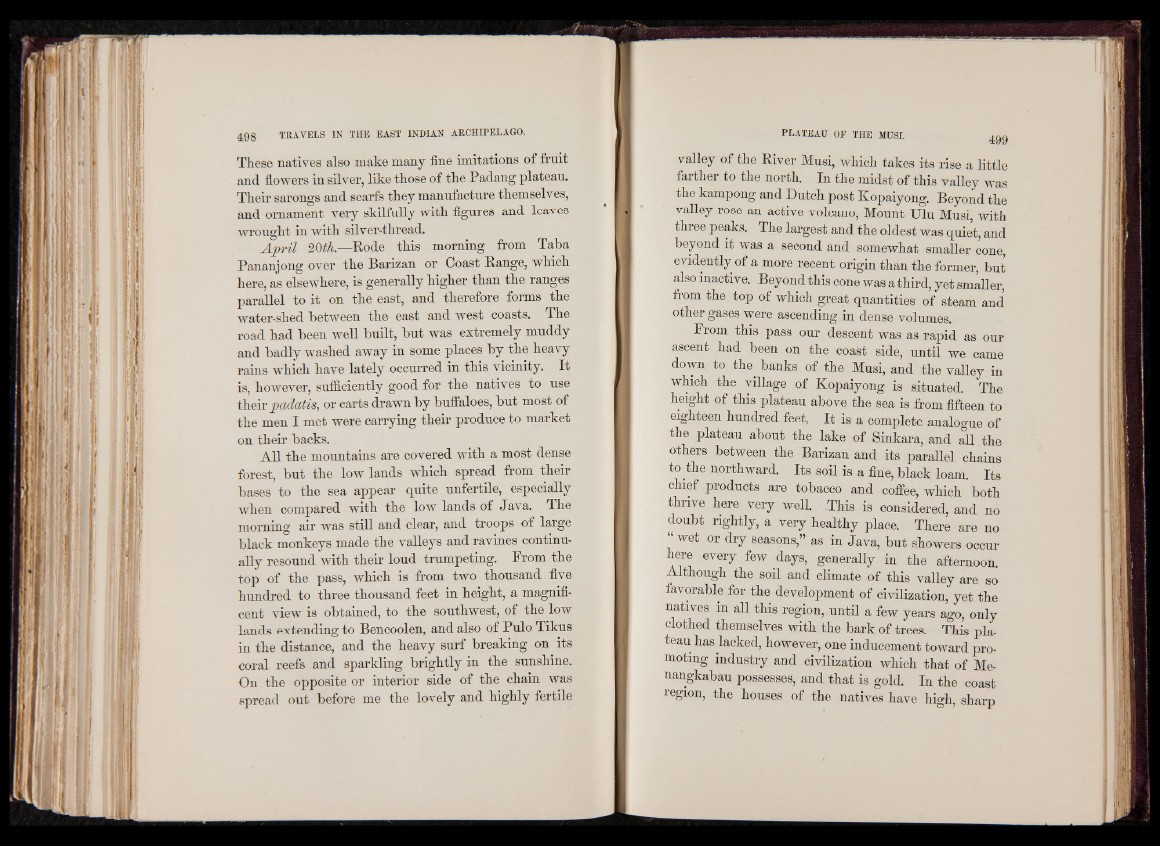
These natives also make many fine imitations of fruit
and flowers in silver, like those of the Padang plateau.
Their sarongs and scarfs they manufacture themselves,
and ornament very skilfully with figures and leaves
wrought in with silver-thread.
A p ril 20th.—Eode this morning from Taba
Pananjong over the Baxizan or Coast Range, which
here, as elsewhere, is generally higher than the ranges
parallel to it on the east, and therefore forms the
water-shed between the east and west coasts. The
road had been well built, but was extremely muddy
and badly washed away in some places by the heavy
rains which have lately occurred in this vicinity. It
is, however, sufficiently good for the natives to use
their padatis, or carts drawn by buffaloes, but most of
the men I met were carrying their produce to market
on their backs.
All the mountains are covered with a most dense
forest, but the low lands which spread from their
bases to the sea appear quite unfertile, especially
when compared with the low lands of Java. The
morning air was still and clear, and troops of large
black monkeys made the valleys and ravines continually
resound with their loud trumpeting. From the
top of the pass, which is from two thousand five
hundred to three thousand feet in height, a magnificent
view is obtained, to the southwest, of the low
lands extending to Bencoolen, and also of Pulo Tikus
in the distance, and the heavy surf breaking on its
coral reefs and sparkling brightly in the sunshine.
On the opposite or interior side of the chain was
spread out before me the lovely and highly fertile
valley of the River Musi, which takes its rise a little
farther to the north. In the midst of this valley was
the kampong and Dutch post Kopaiyong. Beyond the
valley rose an active volcano, Mount Ulu Musi, with
three peaks. The largest and the oldest was quiet, and
beyond it was a second and somewhat smaller cone,
evidently of a more recent, origin than the former, but
also inactive. Beyond this cone was a third, yet smaller,
from the top of which great quantities of steam and
other gases were ascending in dense volumes.
From this pass our descent was as rapid as our
ascent had been on the coast side, until we came
down to tlm banks of the Musi, and the valley in
which the village of Kopaiyong is situated. The
height of this plateau above the sea is from fifteen to
eighteen hundred feet. It is a complete analogue of
the plateau about the lake of Sinkara, and all . the
others between the Barizan and its parallel chains
to the northward. Its soil is a fine, black loam. Its
chief products are tobacco and coffee, which both
thrive here very well. This is considered, and no
doubt rightly, a very healthy place. There are no
“ wet or dry seasons,” as in Java, but showers occur
here every few days, generally in the afternoon.
Although the soil and climate of this valley are so
favorable for the development of civilization, yet the
natives in all this region, until a few years ago, only
clothed themselves with the bark of trees. This plateau
has lacked, however, one inducement toward promoting
industry and civilization which that of Me-
nangkabau possesses, and that is gold. In the coast
region, the houses of the natives have high, sharp